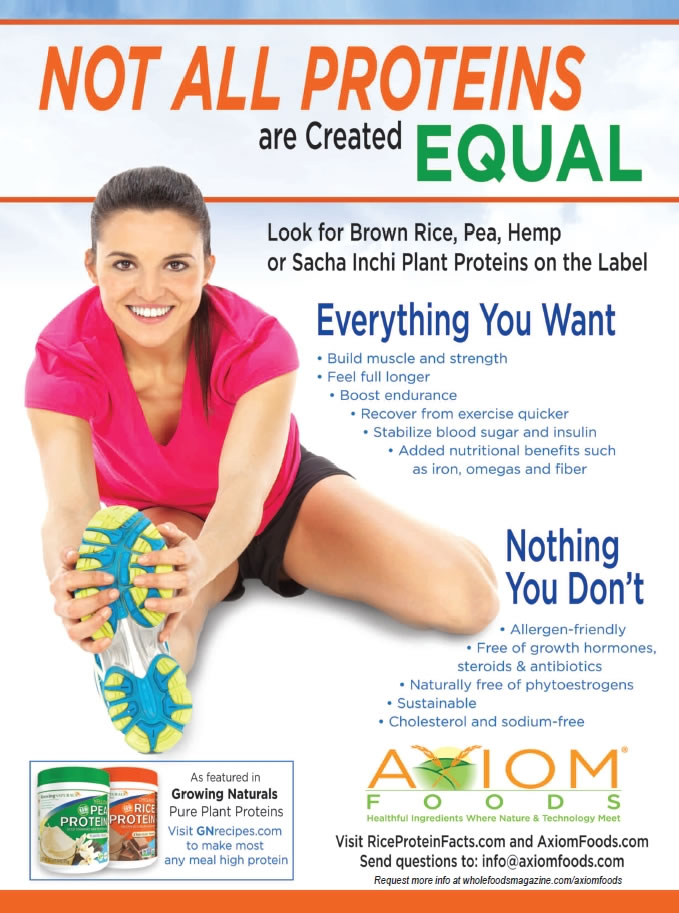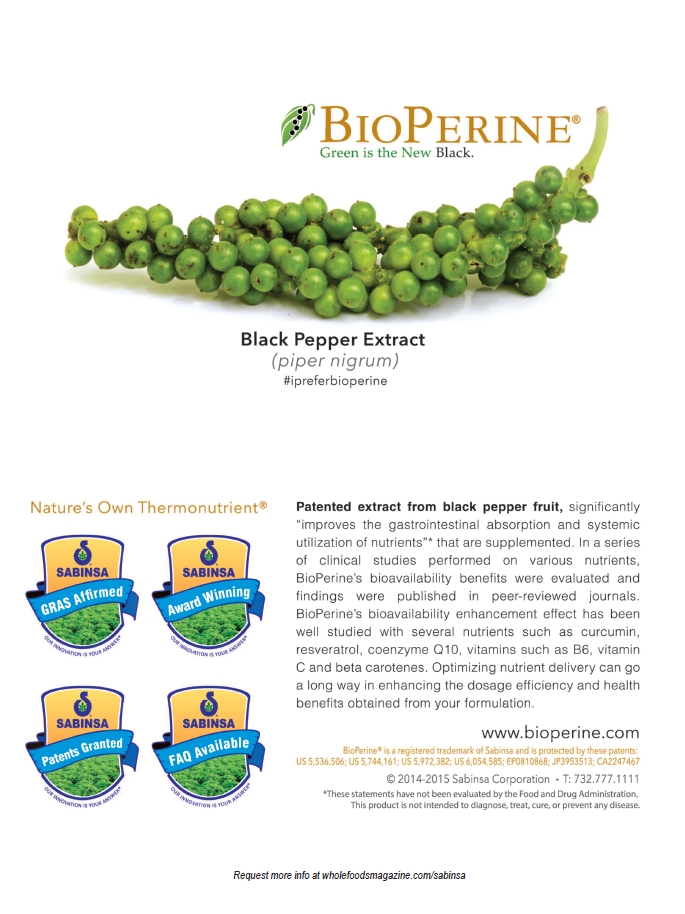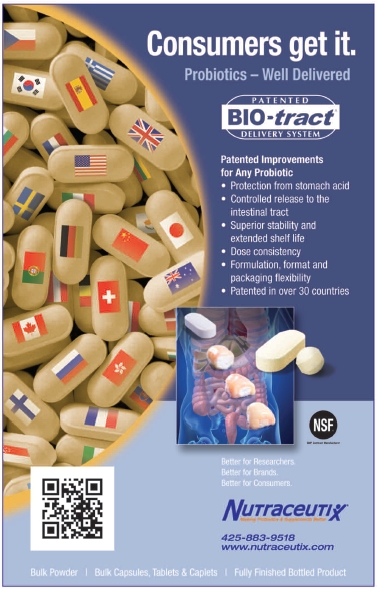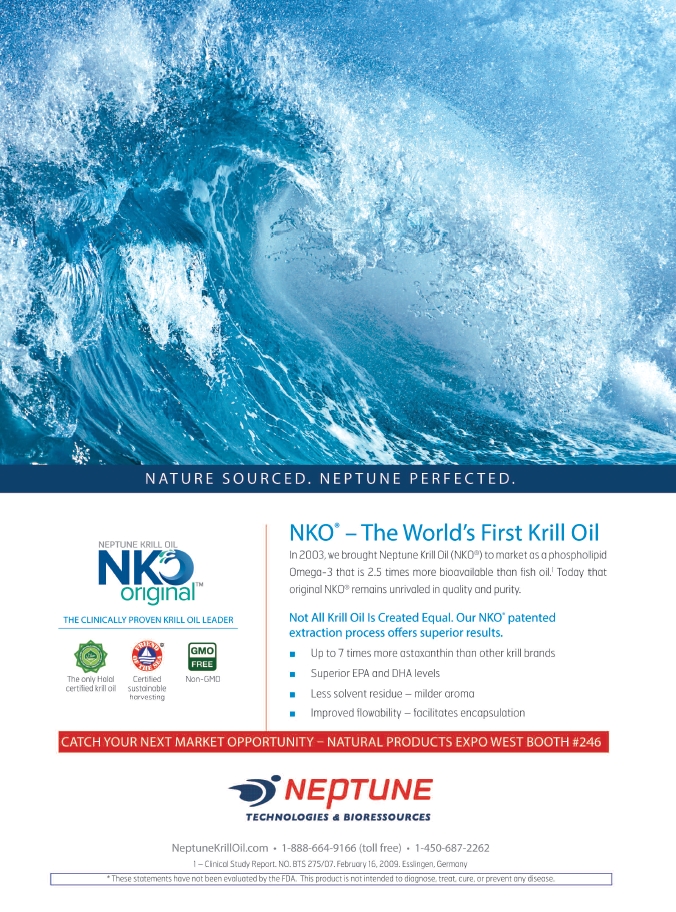Finished products makers looking to buy from a new raw materials supplier—or make sure their current partners are still up to snuff—have a lot of important questions that need answers. Three areas of special concern are ingredient quality traceability, research backing and supply/costs. Several ingredient providers offer key information on these important matters in this report.
Track It DownEveryone from a product formulator to the end user wants to know where food or supplement ingredients come from. This information can be provided by responsible raw material and ingredient suppliers, but is contingent upon companies collecting such details accurately from the direct seller(s) or growers. “A manufacturer needs to source raw materials from reputable suppliers that can support traceability needs, which is easier to accomplish when the materials themselves are certified,” says Tony Blanch, director of quality at Nutraceutix, Redmond, WA.
April Knell, marketing coordinator at Stratum
 Nutrition/ESM Technologies, St. Charles, MO, believes if a company is working with a supplier that cannot meet certain traceability requirements, it’s time to part ways. “Verifiable traceability documentation is key to accurate traceability, not to mention the implementation of such a traceability system between companies,” she states. “The transparency should continue through the ingredient’s ‘life-cycle’ to make known exactly how the ingredient is harvested and what is done to the ingredient as it makes its way to a finished product on the retailers’ shelves.”
Nutrition/ESM Technologies, St. Charles, MO, believes if a company is working with a supplier that cannot meet certain traceability requirements, it’s time to part ways. “Verifiable traceability documentation is key to accurate traceability, not to mention the implementation of such a traceability system between companies,” she states. “The transparency should continue through the ingredient’s ‘life-cycle’ to make known exactly how the ingredient is harvested and what is done to the ingredient as it makes its way to a finished product on the retailers’ shelves.”David Janow, CEO of Axiom Foods (Oryzatein), Los Angeles, CA, explains what some of these data include, from the perspective of his expertise in plant proteins. He says “every commercial food-grade field has a tracking system such as lot numbers,” and storage facilities, factories and shipping vessels that touch raw materials are also documented. “Our factories know the source of the ingredients and generate certificates of analysis based on testing of the materials and ingredients both going into and out of the factory,” he states.
Gunny Sodhi, marketing manager for Ayush Herbs, Redmond, WA, also believes in full transparency throughout the supply chain. “We at Ayush have a standard that goes all the way to the source and that is one of the many reasons we choose a vertical integration outlook with our raw material suppliers, as this ensures we know the quality going into our products and ensures quality for our consumers as well.”
Now, traceability can become even more complicated when manufacturers are interested in specific issues like genetically modified (GM) status, which is definitely a factor consumers want to know about. Becky Wright, marketing director at Aker BioMarine Antarctic US, Issaquah, WA, says that more U.S. shoppers are seeking “non-GMO” on food labels than “organic,” according to the 2014 Market LOHAS MamboTrack Natural and Organic Shopper Survey. “This signals a critical development in the food and dietary supplement industry, and speaks very loudly to the fact that consumers want to know where their products come from,” says Wright. “More than ever they demand transparency, and traceability is certainly part of that commitment along with other attributes such as sustainability and product quality.”
|
What’s Keeping You Up at Night? And the headline reads: [Company Name] Issues Voluntary Nationwide Recall of [Product Name] Dietary Supplement Due to Undeclared Dexamethasone and CyproheptadineAnd the company’s Web site reads: “All of our products are made using the highest quality of ingredients that are incessantly tested for purity. We use only the finest and most expensive raw materials that money can buy to create all of our synergistic formulas.”  I have heard there is a debate in our industry as to the importance of transparency in manufacturing, and that some in our trade believe that traceability is just a fad and will fade quicker than the latest diet craze. Frankly, little could harm our industry more than a cavalier attitude to these very important topics. I have heard there is a debate in our industry as to the importance of transparency in manufacturing, and that some in our trade believe that traceability is just a fad and will fade quicker than the latest diet craze. Frankly, little could harm our industry more than a cavalier attitude to these very important topics.Our responsibility as advocates in our industry of natural and alternative health products is first and foremost to the consumer. We make a pledge and a promise every day that what we make, what we sell and what the customer buys is above anything else…safe. Yet many believe that the greatest threat to our livelihood is pending legislation in Congress and increased regulation from politicians. That very well may be, but I contend that if you don’t want the government to control headlines like the one above, then you had better be willing to step up and add oversight to your supply chain; transparency in ingredients and traceability—through the source, and to the seed, if necessary. General Electric (GE), one of the world’s largest manufacturers of jet engines, traces every screw in each engine from the manufacturer to the supplier of the steel used to make that screw. Why are we so hesitant to trace our raw materials back to the source? Or better yet, disclose that source? GE regularly audits suppliers for compliance to manufacturing specs, and they test finished components for quality and stability at regular intervals. Our responsibility for customer safety, which is at the very core of consumer trust, should never be outsourced, delegated or contracted without oversight. Every customer that took his or her multivitamin today should do so with the same confidence all of us who travel have every time we board a plane. While we believe the majority of dietary supplement manufacturers work diligently to provide products that are exactly what their labels claim, we also know some companies do not. There are two principal types of dietary supplement adulteration: performance and economic. Examples of performance-related adulteration generally result from an undisclosed additive to the product, usually a drug, to exaggerate performance. Economic adulteration generally results in either producing product with a reduced quantity of active ingredients compared to label claim, or in the case of melamine in China, finding a drug or chemical replacement to the active ingredient that looks similar when tested and is used to “cut” the raw material to save money. In either case, as manufacturers and retailers within the natural space that want to distance ourselves from those that choose an “adulterated” path, we must embrace a supply chain strategy that puts the customer first. By adopting transparency with ingredients and traceability in sourcing as attributes to differentiated customer service, we place consumer trust and safety ahead of self interest, and we establish a new paradigm—away from the above headline, by which we are all measured, and maybe then...achieve a better night’s sleep. —Tom Tolworthy, president and CEO of Twinlab Corp. |
“The reason why the seed is important is that everything starts there,” he believes. “Does the soil have the water table to provide a good yield out of a non-GM seed, and is it isolated enough from GM products to avoid cross-pollination and contamination? Is it upwind from the natural wind pattern that goes through the region?” he asks. He also believes good-quality soil (being low in pesticides and lead with a high water table) can enhance product quality.
Proving a product’s non-GMO status through a process like the Non-GMO Project Verified program requires companies to do their homework. Jen Johansen, vice president of quality and regulatory affairs for Cyanotech, Kailua-Kona, HI, says going all the way to the source “can be complicated, but necessary” when companies seek compliance with rigorous standards like that of the Non-GMO Project Verified program. For instance, she states, “Some ingredients, like probiotics, undergo processing steps that involve substrates. The source of the substrates must also be traced and evaluated.”
Johansen believes the Project’s standards are rigorous, and require a lot of documentation. As a result, buyers of a Non-GMO Project Verified ingredient will have a certain level of confidence in the fact that the ingredient has been traced to the source.
Other market areas take traceability just as seriously. On the krill front, for instance, Wright says her company’s krill traceability is verified by the Marine Stewardship Council (MSC) as part of its sustainability certification, and has pending approval from the Non-GMO Project for the non-GMO status of its krill oil. Says Wright, “It’s one thing to say you are ‘100% traceable’ and another to be ‘certified’ as being 100% traceable. I firmly believe that the claim of traceability must be verified by a third party.” The company also uses a GPS tracking system that records the exact location of each krill catch. End users can find those coordinates on the label of their bottle to see where the krill was caught.
In the end, suppliers agree that traceability requires concerted effort and commitment. States Bruce Abedon, Ph.D., director of scientific affairs at NutraGenesis LLC, Brattleboro, VT, “A key aspect of traceability is if the ingredient supplier is vertically integrated and so can manage all levels of production with records of each step.”
Having a vertical manufacturing process is even more important than traceability alone, says Vladimir Badmaev, M.D., Ph.D., founder and CEO of American Medical Holdings, New York, NY. “You can trace your material to a specific geographic area, but if you do not have control of the supply chain you do not have vertical manufacturing of your product,” he believes.
He outlines how this could work: one company owns large fields for growing a raw material that is stored in its own facility with controlled and hygienic conditions, and then goes to its own extraction facility that uses a dedicated clean line for processing it, and the finished product is packaged in its own facility.
“Recent problems in our industry include contamination with melamine, plasticizers and re-used cooking oil in China and Taiwan; this exemplifies that traceability of a nutritional product must involve vertical organization of manufacture,” says Badmaev.
Research: What Should You Trust?What exactly is “well-designed”?Barbara Davis, Ph.D., R.D., director of medical and scientific affairs at PLT Health Solutions, Inc., Morristown, NJ, makes the point that traceability is also linked with another key supplier issue: high-quality research.
Davis says traceability is practically a given for her company’s ingredients, and one reason centers on the clinical trials that support them. “When we are supplying an ingredient that is supported by clinical trials, we have to have extremely exacting standards on how the ingredients are grown—and then how they are harvested, stored and processed,” she explains.
The company has good reason to go to such lengths. After all, an ingredient’s biochemical makeup can vary from region to region and field to field. When a study is confirming the benefits of a specific makeup, the company must ensure it is delivering that exact same form each and ever time. Says Davis, “For example, our Synapsa Memory Support ingredient—which is the subject of seven human clinical trials—has to deliver a ‘fingerprint’ of phytochemicals from batch to batch and customer to customer.”
Sebastien Bornet, director of global marketing at Horphag Research (worldwide exclusive supplier of Pycnogenol), with headquarters in Geneva, Switzerland, feels the same way. He explains that “traceability is core to the Pycnogenol story,” which includes ongoing screening of more than 60 products per year to ensure that consumers around the world are getting 100% pure Pycnogenol. “It’s a trust that’s at the center of our customer relationships,” he states. “If you buy Pycnogenol, you get Pycnogenol and the science that comes with it.”
As the U.S. Food and Drug Administration (FDA) and the Federal Trade Commission (FTC) monitor companies’ structure–function claims (and take appropriate action when needed), manufacturers need to define for themselves what a gold standard study is in their minds, and what their standards are for high-quality research coming from ingredient suppliers. Indeed, many developers of branded ingredients are leaders in the area of nutrition research, which manufacturers might then use to support a structure–function claim (though it should be noted that manufacturers of custom formulations should test the finished product, too). So, interviewees for this piece were asked about what they use as benchmarks for designing a meaningful clinical trial.
Abedon hits on several points important to his company, which were common among other industry insiders, too. A well-designed trial should: • involve healthy subjects, who have given informed consent
 • include enough subjects per placebo/active group to detect significant differences
• include primary and secondary objectives
• be randomized, double-blind and placebo-controlled
• include enough subjects per placebo/active group to detect significant differences
• include primary and secondary objectives
• be randomized, double-blind and placebo-controlledWithin this framework, there are countless nuances. The length of the study is one example. Badmaev says researchers testing a nutritional compound for weight loss, for instance, may want to first see whether it changes the body fat to lean body mass ratio over several weeks. “The next step could evaluate the degree and dynamics of body weight loss as well as metabolic function parameters (e.g., blood lipids, blood sugar homeostasis, and inflammatory indices like C-reactive protein),” he states.
Anne Bjornebye Vik, Ph.D., MBA, director of regulatory affairs with NattoPharma ASA, Hovik, Norway, adds other examples. If researchers are looking at serum protein biomarkers, she says the real clinical endpoint must be reached within one year. Meanwhile, “If one looks at the change in bone mineral density and/or bone fractures, this may take years to register/measure, which is why our study on healthy post-menopausal women published inOsteoporosis International was a three-year study,” she states.
The placebo aspect of a study is absolutely key for most companies. “The investigators along with the contract research organization dispense the product to be tested in a blinded fashion, meaning that the product and the placebo should be similar in taste, smell and appearance,” states Pierre Lemieux, COO of Acasti Pharma, a subsidiary of Neptune Technologies & Bioressources, Laval, QC, Canada. “The study participants do not know what they take and this creates an unbiased study.”
Johansen adds that using healthy subjects is key, since it best supports structure–function claims in a regulatory framework where supplements cannot claim to cure, prevent or treat any disease.
The issue of the number of participants is often used as a marker of a study’s significance. “The cost is worth it to include 25, 50 or 100 subjects depending on what your endpoints are,” says Johansen.
|
What I’ve Learned about Gold-Standard Clinical Trials: One Supplier’s Perspective The Nutra landscape has been changing dramatically over the past several years and it looks like the ever-changing guidelines of the U.S. Food and Drug Administration and Federal Trade Commission have been driving this. My company (Helios CORP) is aggressive in adapting to these changes with our branded ingredients. As the Nutra industry becomes more pharma-like, we have continued to expand our clinical studies and proof-of-performance claims. have continued to expand our clinical studies and proof-of-performance claims.It looks like finished products manufacturers might be further challenged to provide evidence when making a claim on a finished product bottle. Our intent is to make this process easier by continuing to focus on broader and deeper clinical science to support our customers and future customers who need the ability to support label claims with extensive clinical evidence. Not all clinical studies are created equal and we are committed to the process of conducting our first, second and third clinical studies at independent test sites that can provide independent results. This sets the bar for the quality of claims we present to our customers. An important piece we also discovered was the need to have at least two clinical studies utilizing the same test methods and protocols, thus eliminating the variables in differing end point claims. The investment was worth it for us when completing our third clinical study with our menopause ingredient (EstroG-100). The results were similar and, most importantly, our customers now have the ability to expand their structure–function claims when offering the ingredient for menopause support in the retail sector. Several companies have shared with us that the EstroG-100 clinical evidence we presented is the Gold Medal standard—meaning two clinicals with the same test methods and protocols, not simply two clinical studies that might vary quite a bit. We shall see as the Nutra industry continues to evolve and change with these new rules and regulations. My firm continues to develop new ingredients with multiple clinical studies and expand our existing clinical profile with our existing branded ingredients. The goals are the same for us, which is to raise the bar and set a standard that we believe is inevitable in the Nutra category. More and more evidence is showing up in print and media outlets that this amazing industry we are in might be evolving toward the pharma model. Thus, when media or prospective customers ask about our science, we make a point of discussing not only the science but also where the clinical evidence originates. Understanding safety and performance is key for our customer base. — Michael Jeffers, president of Helios CORP |
Knell adds that the markers tested should be objective and not subjective “as there can be so much variability in interpretation of subjective markers.”
Others, too, feel that manufacturers should be on the lookout for ethics in the study design before relying on its results. Mark Morris, vice president of ChromaDex, Irvine, CA, says the study protocols should be approved by the Institutional Review Board. Dijkstra, who also supports a study’s objective execution, says in many cases trial registrations must be observed and followed. He points readers towww.clinicaltrials.govfor a list of registered clinical trials, and calls it “an excellent starting point for those who are unfamiliar with this area.”
Another aspect of the ethics question is where the trial is conducted. Many companies are in favor of research conducted outside their walls such as at a contract research firm or by university researchers with an interest in the ingredient. “At Horphag, all of our clinical studies conducted on Pycnogenol are by independent scientists and researchers who establish and follow properly designed protocols that allow conclusions based on scientific evidence,” says Carolina Burki-Sozzi, director of product development at Horphag Research.
Badmaev believes conducting multicenter studies “is probably the best insurance policy against falling into the trap of an insufficiently researched product.”
It’s also important to note that companies may collect worthwhile information about ingredients before getting to the human clinicals stage. While non-human trials may or may not be enough on their own to support a claim (as it depends on whether they can be considered reasonable substitutes for human research), they can provide important insight about an ingredient.
Abedon says in addition to well-designed human clinical trials, “It is helpful if there are also pre-clinicalin vitroandin vivostudies that also support the ingredient and demonstrate results that are confirmed in the human trial.”
Mitch Skop, senior director of new product development, Pharmachem Laboratories Inc., Kearny, NJ, explains how: “First, you have to crawl, then walk, then run. Crawling, in this case, means investigating the ingredient through in vitro (laboratory) analysis to discover its characteristics and if it is viable for human consumption. Second are animal studies to see how it impacts biological systems in specific applications, as well as LD 50 studies (for safety). Third, running, comes the human clinicals. Placebo-controlled, of course, is imperative.”
Is “gold standard” enough? According to Larry Robinson, vice president of scientific affairs at Embria Health Sciences, Ankeny, IA, “Most scientists agree that the double-blind placebo-controlled randomized clinical trial is the best design.” This certainly can provide high-quality, significant results, but there’s more to know.
Robinson says this approach might not be practical for certain food ingredients. “For example, if studying the effect of a common vitamin, the placebo group will still be exposed to the test product because vitamins are present in the foods we eat,” he explains. “Therefore, since both placebo and test groups are exposed to the same vitamin under study (just at different levels), it may be more difficult to show a positive effect even though one exists.”
Also, for those looking to make allowable data-backed structure–function claims, many believe agencies are looking for several high-quality positive studies. But according to Knell, “FDA explains that there is no pre-established formula as to how many or what type of studies are needed to substantiate a claim, but they do recommend consideration of the meaning of the claim, the relationship of the evidence to the claim, the quality of the evidence and the totality of the evidence."
She believes that FDA appreciates high-quality, human intervention studies (e.g., randomized, double blind, parallel group, placebo-controlled trials) or observational studies (e.g., cohort studies).
Meanwhile, Knell says, “FTC appears to be judging truth in marketing on a minimum of two randomized controlled trials for the purpose of substantiating structure–function claims.”
This topic is ripe for discussion, and in the
 sidebar “What I’ve Learned about Gold-Standard Clinical Trials: One Supplier’s Perspective,” Michael Jeffers, president of Helios CORP, makes the case that it’s not enough for there to simply be two well-designed studies; they should have a similar design, too.
sidebar “What I’ve Learned about Gold-Standard Clinical Trials: One Supplier’s Perspective,” Michael Jeffers, president of Helios CORP, makes the case that it’s not enough for there to simply be two well-designed studies; they should have a similar design, too.The recent FTC court case involving Bayer’s claims on Phillips Colon Health products speaks to the need for industry companies to collect significant clinical trial evidence before making structure–function claims. The FTC believes that Bayer is making unsubstantiated claims about its Phillips’ Colon Health probiotic supplement. The company stated in marketing materials that the product can “defend against” occasional constipation, diarrhea and bloating, and implied it can prevent constipation, diarrhea and bloating. The court believes the company does not have sufficient scientific evidence to back those claims and needs to do testing in humans on the specific probiotic strains in its supplement to substantiate any claims.
Some believe this is out of bounds; requiring product-specific, randomized, double-blind, placebo-controlled human clinical trials is a standard that drugs must follow, not supplements. How the situation plays out in the courts is something the industry is closely following. Says Jeffers, “We believe this court case will have a direct and significant bearing on our industry.”
Blanch agrees, noting that “potentially, it could set precedent for what constitutes acceptable clinical evidence, whether unrelated studies can be used in support of a new claim, and even what claims may be considered as allowable without clinical trial evidence. Are structure–function claims acceptable without formal scientifically reviewed clinical evidence proving effect? Does the clinical evidence have to be generated on the exact final dose form of the supplement? The answers may result from this case.”
He believes it’s possible the end result could even be industry companies moving away from making functional claims and away from performing basic nutritional research for fear of litigation.
 How do you know when you’re “done”?Morris says research “should always continue, but at minimum, you must ascertain the mechanism of action through multiple studies and demonstrate consistent efficacy and a robust safety profile.”
How do you know when you’re “done”?Morris says research “should always continue, but at minimum, you must ascertain the mechanism of action through multiple studies and demonstrate consistent efficacy and a robust safety profile.”Many companies believe that research is never really “done.” Says Lemieux, “There are always new areas and avenues of research that could be explored in order to satisfy the regulatory bodies that approve claims of a product/ingredient.”
Using an example from Skop, a branded ingredient from his firm (Phase 2) has 18 clinicals, “yet, the more clinicals we can perform with slightly different populations and in different countries that reflect trends, and with positive outcomes, will further substantiate the efficacy of our product.”
Continuing to research already data-backed ingredients is something Davis feels is “a form of support for your customers who are looking to build their own consumer brands, and these brands need continued nurturing.”
Many times, Janow says, research provides some answers, but often leads to even more questions. And customers deserve the follow-up. As Badmaev puts it, “The initial success does not release the company from repeating and perpetual continuation of the research of the product.”
What about results that don’t go as planned?Blanch believes hiding negative results is not the way to go. “They must be reported as part of the body of evidence for efficacy, but investigation into cause for the negative result must be thorough enough to propose a rationale that can discount their impact on the overall outcome of the clinical investigations’ positive findings,” he states.
Johansen says when companies collect data that don’t go as planned, the claims and study design should be re-evaluated. “In some cases, the results may be directional but not significant and you could consider additional studies with a larger number of participants,” she believes.
Skop actually believes that negative results can be extremely valuable, since they offer information about which parameters of an ingredient do not work. He quotes Sir Francis Bacon, saying, “Knowledge is power.”
 Pricing and AvailabilityOf course, pricing and availability discussions are a given with suppliers. How are recent extreme weather patterns affecting suppliers?
Pricing and AvailabilityOf course, pricing and availability discussions are a given with suppliers. How are recent extreme weather patterns affecting suppliers?Knell believes widespread drought can have a ripple-effect through many raw materials, but Mark Joyner, director of operations at Embria, says it’s usually temporary. “When working with natural products, you are used to these fluctuations and contain cost by improving processes and finding other ways to reduce costs,” he states.
Pontiakos speaks of the current droughts in the western United States. In late July, the U.S. Drought Monitor said 58% of the state of California fell into the “exceptional” drought category, the worst level, and more than 80% percent was in “extreme” drought. The ongoing drought is affecting the state’s agricultural production, with Pontiakos stating it is killing yields for growers in the San Joaquin region. “There are thousands upon thousands of people in that area depending upon agriculture for their jobs, and thousands of farmers are going out of business. It’s an absolute tragedy,” he feels.
In the end, manufacturers that source from the area (and other places hit by extreme weather) will likely feel the squeeze. Says Sodhi, “It already has affected prices for certain items and these extreme weather changes do affect prices because supply is extremely cut short.”WF

|
2015 Health and Wellness Trend Watch Supplements use is on the rise, possibly because more people are seeing this as a way to invest in their own version of “personal health insurance,” says April Knell, marketing coordinator at Stratum Nutrition/ESM Technologies.Here are some trends industry suppliers believe you should have your eyes on in 2015. • Weight  management
• Sports nutrition
• Condition-specific products that address healthy joints, bones, eyes, blood sugar, cognition, cardiovascular system and digestion
• Immune–digestive health combination products
• Omega-3 combination products
• Stress management
• Metabolic wellness
• High-protein shakes and meal replacements
• Protein used in non-traditional formats such as face care products
• Unique delivery forms like effervescent tablets, chewables, gummies, syrups and lozenges
• Probiotics for use outside the digestive tract
• Non-GMO labels
• Products that serve the needs of the aging population such as menopause support management
• Sports nutrition
• Condition-specific products that address healthy joints, bones, eyes, blood sugar, cognition, cardiovascular system and digestion
• Immune–digestive health combination products
• Omega-3 combination products
• Stress management
• Metabolic wellness
• High-protein shakes and meal replacements
• Protein used in non-traditional formats such as face care products
• Unique delivery forms like effervescent tablets, chewables, gummies, syrups and lozenges
• Probiotics for use outside the digestive tract
• Non-GMO labels
• Products that serve the needs of the aging population such as menopause support |
See www.wholefoodsmagazine.com/suppliers for additional coverage of the supplier category.
Published in WholeFoods Magazine, January 2015










